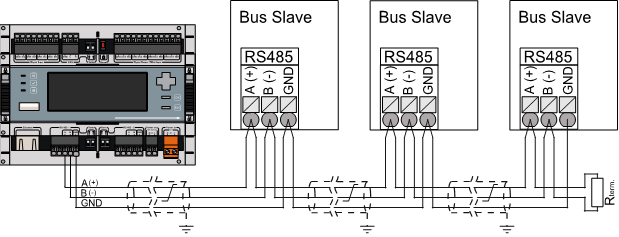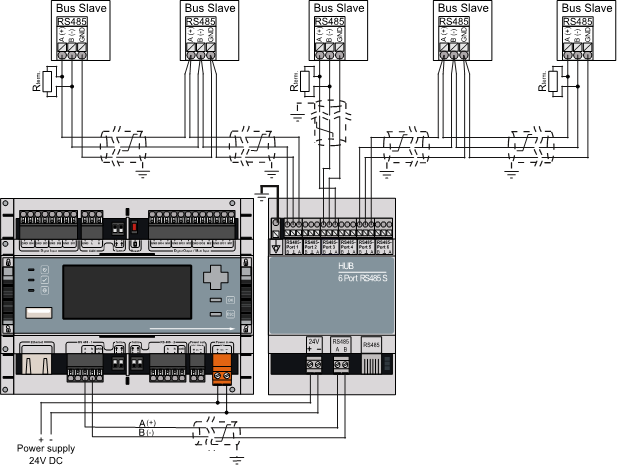Last modified:
RS485
The blue’Log is equipped with two RS485 interfaces (RS485-1 und RS485-2) for connecting bus devices. These can query information from typical bus devices such as inverters, energy meters, string monitoring systems and power analyzers. Sensors and meters can be queried together if they communicate via Modbus.
Please note the following regarding the bus cabling:
-
Each RS485 interface supports only a single protocol (for example, Modbus).
-
Devices from different brands or categories with a Modbus RTU protocol can be mixed at one bus line. However, this is not recommended because it reduces the performance and quality of Monitoring and Power Control functions.
-
If devices from different brands or categories with a Modbus RTU protocol are connected to one RS485 interface, then the baud rate and protocol frame of the RS485 settings must be the same. See Kompatibilitätscheck.
-
The blue’Log functions exclusively as a Master on the bus.
-
Observe the maximum permitted number of bus devices. See Kompatibilitätscheck.
-
The order of the bus devices on the bus is unimportant.
-
A repeater must be used for every 32nd bus device and for long cable runs.
-
The bus should be cabled with a twisted and shielded pair of wires.
-
The shield of the bus cable must be grounded at one end of the connection only. The blue’Log does not have its own grounding.
-
When wiring the bus wires, the AC and DC cables must be routed separately.
-
Do not switch the bus signal wires.
-
Manufacturers interpret the underlying standard of the RS485 interface differently. This means that the A and B wire labels may be different depending on the manufacturer. The + and – indicators, on the other hand, are unambiguous.
-
To prevent reflections, the bus must always be terminated with a parallel terminator.
-
For more information, see the device connection plans.
Daisy chain
If you want to connect more than one device to the bus, you must daisy-chain the connection. This means different devices can only be queried jointly if they use the same communication protocol and the same serial communication parameters (baud rate, data bits, parity, stop bits).
The first and last device on the bus must be terminated with a resistor. The blue’Log has integrated terminating resistors, which can be turned on/off via the termination switches.

Star wiring
An equally viable option for operating multiple devices on the RS485 bus is star wiring. In this variant, the HUB 6 Port RS485 S (product number: 421.641) is used to separate the bus into several bus lines.
Various devices can only be queried together if they communicate with the same protocol and the serial communication parameters are identical (baud rate, number of data bits, parity, stop bits).
Each bus string can have a maximum length of 1200 m. All devices on the same bus string are wired together in the daisy chain. The first and last device of each bus string must be terminated by a resistor. The HUB has integrated terminating resistors at each interface, which are permanently active.
In this wiring variant, the total number of bus devices may not exceed the maximum number to bus devices.

Digital inputs, digital outputs, and multi-inputs
The blue’Log has interfaces for digital inputs (DI), digital outputs (DO), and multi-inputs (MI). Typical devices for these interfaces are ripple control receivers, remote control systems, and sensors.
-
Digital inputs (DI): Since the inputs are energized (wet contacts), they must be equipped externally with potential-free contacts (dry contacts) to ground.
-
Digital outputs (DO): Active high/low or GND/1MΩ. Can be configured as normally closed or normally open contacts, or with the output voltage (24VDC).
-
Multi-inputs (MI): Can either be configured as analog inputs (0V..10V, 0mA..20mA or 600…1800Ω to be read as sensors) or as normal DIs.
-
All inputs and outputs can be configured via the blueLog web interface under Devices.

|
Item |
Description |
|
|---|---|---|
|
1 |
NO |
Normally open contact |
|
2 |
NC |
Normally closed contact |